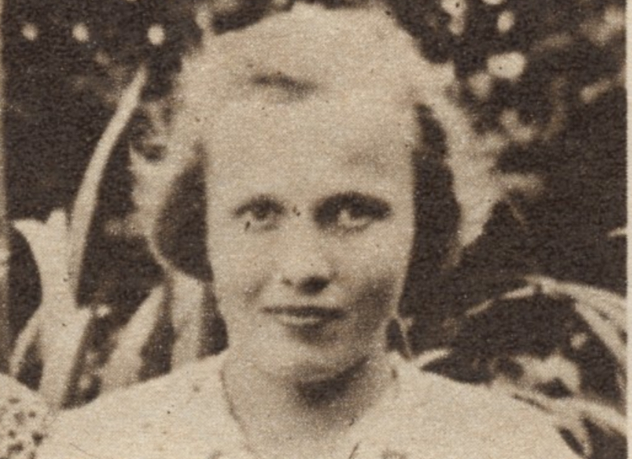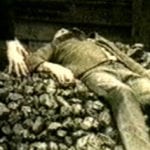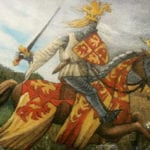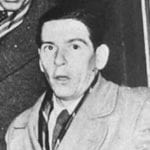 Weird Stuff
Weird Stuff  Weird Stuff
Weird Stuff  Animals
Animals 10 Inspiring Tales of Horses Being Human
 Mysteries
Mysteries Top 10 Haunting Facts About the Ghost Ship MV Alta
 History
History 10 Surprising Stories About the Texas Rangers
 Humans
Humans 10 Philosophers Who Were Driven Mad by Their Own Theories
 Miscellaneous
Miscellaneous 10 Video-Game-Worthy Weapons and Armors from History
 Weird Stuff
Weird Stuff 10 Psychics Who Accurately Predicted Wartime Events
 The Arts
The Arts 10 Pieces of Art Inspired by a Broken Heart
 Health
Health 10 Science Fiction-Sounding New Medical Treatments
 History
History 10 Surprising Facts About the Father of Submarine Warfare
 Weird Stuff
Weird Stuff 10 Times Real Laws Were Based on Bizarre Hypotheticals
 Animals
Animals 10 Inspiring Tales of Horses Being Human
 Mysteries
Mysteries Top 10 Haunting Facts About the Ghost Ship MV Alta
Who's Behind Listverse?

Jamie Frater
Head Editor
Jamie founded Listverse due to an insatiable desire to share fascinating, obscure, and bizarre facts. He has been a guest speaker on numerous national radio and television stations and is a five time published author.
More About Us History
History 10 Surprising Stories About the Texas Rangers
 Humans
Humans 10 Philosophers Who Were Driven Mad by Their Own Theories
 Miscellaneous
Miscellaneous 10 Video-Game-Worthy Weapons and Armors from History
 Weird Stuff
Weird Stuff 10 Psychics Who Accurately Predicted Wartime Events
 The Arts
The Arts 10 Pieces of Art Inspired by a Broken Heart
 Health
Health 10 Science Fiction-Sounding New Medical Treatments
 History
History 10 Surprising Facts About the Father of Submarine Warfare
10 International Historical Murder Mysteries
Murders happen every day. It’s hard to tell exactly what characteristics turn certain crimes into media sensations while others quickly fade into obscurity, but a murder mystery is always guaranteed to captivate an audience. Whether through careful planning, sheer luck, corruption, or police incompetence, these killers all managed to get away with their crimes.
10 Chrissie Venn
Australia

On March 1, 1921, the body of 13-year-old Chrissie Venn was found in a hollow tree stump near the village of North Motton in Tasmania. Chrissie had disappeared on February 20, when she left her home on Allison Road to run errands in the village.
After the discovery of her body, newspapers gave conflicting reports. They initially stated that Chrissie was murdered on February 21 and that her body was mutilated. Later, the date was changed to February 26, and it was reported that Chrissie had been strangled or suffocated and that her body only featured defensive wounds.
People quickly pointed fingers at George William King, a 35-year-old former miner and policeman. He was charged with the murder. King was seen in the area where Chrissie disappeared around the same time, and other people noted that he tried to speak to her whenever they met, even though the girl usually tried to dismiss him. King also had scratches and marks on his hands, which he claimed that he sustained while participating in a search party looking for Chrissie while she was still missing.
When police searched King’s home, they found an anonymous letter addressed to him. The author claimed to have seen King murder Chrissie and urged him to confess. The writer never came forward as a witness. At his trial, King was represented by Albert Ogilvie, future premier of Tasmania. Ogilvie secured a not guilty verdict by proving that the witnesses who gave circumstantial evidence against King weren’t very reliable. Chrissie Venn’s murder remains unsolved.
9 Hinterkaifeck Murders
Germany
In the early 20th century, Hinterkaifeck was the unofficial name of a farmstead located between two cities in Bavaria, situated in modern-day Waidhofen. The location became infamous after all its residents were murdered on March 31, 1922, in what would become one of Germany’s most notorious unsolved crimes.
Six people were killed that day—the farm owner Andreas Gruber, his wife Cazilia, their daughter Viktoria, their grandchildren Cazilia and Josef, and the maid, Maria Baumgartner. The murder weapon was determined most likely to be a mattock, a tool similar to a pickax with an ax blade on one side.
Four of the victims were found in the barn, where they were probably lured and killed one by one. Afterward, the killer(s) went inside the house and murdered baby Josef and the maid. At first, police suspected robbery as the primary motive, but the idea was dismissed after valuables and money were found inside the home. Furthermore, the perpetrator spent time at the farm after the killings, according to neighbors who saw chimney smoke after the Grubers were dead.
People in town reported that Andreas Gruber had complained of odd things happening at the farm days prior to the murders—footprints from the forest leading to the house, weird noises in the attic, and his house keys disappearing. However, he never reported them to the police.
The farm was demolished in 1923, making all subsequent investigations more difficult. Despite questioning over 100 suspects, no one was ever charged.
8 Janet Smith
Canada

Between 1924 and 1925, newspaper headlines in Vancouver all wondered the same thing: “Who killed Janet Smith?” It was a controversial case, and conspiracy theories abounded. Even now, 90 years after the fact, we still don’t have an answer to that question.
Janet Smith was born in Scotland in 1902. When she was murdered on July 26, 1924, she was a nursemaid working for the Bakers, an affluent Vancouver family. Her body was found with a bullet wound in her head and a revolver near her outstretched arm. Police and the coroner’s office labeled her death a suicide after a quick investigation, one of the first things that made people suspect that something more sinister was afoot. The Vancouver Star, in particular, was the first to paint the picture of corrupt police trying to cover up a murder.
Eventually, the attorney general ordered the case reopened. Smith’s body was exhumed, and her death was ruled a murder. The Baker’s Chinese houseboy, Wong Foon Sing, became the primary suspect after claims that Smith spurned his romantic advances. Some people believed that the police were pinning the murder on an easy target.
The case took a shocking turn when Sing was kidnapped by KKK members. They imprisoned and tortured him for six weeks in an attempt to force a confession. Eventually, charges against Sing were dropped, and he returned to Hong Kong.
One rumor accused wealthy playboy Jack Nicol of raping and killing Smith and then bribing police to cover his deed. Another theory pointed at the man of the household, Frederick Baker, who killed Smith after she discovered his secret smuggling operation. Nobody else was ever charged with the murder.
7 Kyllikki Saari
Finland

On May 17, 1953, 17-year-old Kyllikki Saari was murdered on her way home from the local church in Isojoki. A month later, her bicycle was found in a marshy region near her route. On October 11, her body was found around the same area.
Saari’s murder caused massive outrage in Finland. Tens of thousands of people attended her funeral, and thousands more petitioned the Finnish government to reinstate the death penalty so that her killer would be hanged when he was apprehended. Little did they know that her killer would never be found.
The first viable lead came when a local farmer began to ask around if the police had found Saari’s missing shoes. At the time, that detail hadn’t been made public, so naturally, it made the farmer a solid suspect to the police. However, he provided an airtight alibi which took him out of contention.
Several more suspects were investigated, but none of them were charged. One of them was Hans Assmann. He was a German immigrant who’d allegedly served in the SS during World War II before becoming a KGB spy when he was captured by the Russians. In 1997, on his deathbed, Assmann contacted editor and former police officer Matti Paloaro to tell him his life story. While he never admitted to anything, he made references suggesting that his driver accidentally ran Saari over, and the two of them covered up the murder.
6 Josslyn Hay
Kenya

The deaths of the rich and famous always generate a lot of attention. When such a person’s life (as well as their death) is surrounded in controversy, it’s going to become one of the biggest headlines of its day.
That was the case with Josslyn Hay, earl of Erroll. Born into a family of British diplomats, Josslyn was on track to follow in his father’s footsteps. However, he caused a major scandal in 1923 when he married Lady Idina Sackville, an older socialite who divorced her second husband to be with Hay.
In order to escape the scandal following their lives, the newlyweds moved to Kenya. There, they became part of the so-called Happy Valley Set, a group of wealthy, powerful whites known for their rich, decadent lifestyles and party attitudes. However, the party ended for Hay on January 24, 1941, when he was found shot dead in his car on the Nairobi-Ngong road.
A lot happened to Hay during his time in Kenya. He divorced Lady Idina and married his second wife, who died in 1939. At the time of his death, Hay was having an affair with Lady Diana Broughton. Her husband, Sir Delves Broughton, became the obvious suspect and was charged with murder. However, he was found innocent due to lack of evidence.
Broughton committed suicide a few months later, which was a clear sign of guilt to many. Plenty of people still claim unequivocally that he was the culprit. However, other intriguing suspects have been put forward. They included Lady Broughton herself, as well as Alice de Janze, a fellow Happy Valley Set member and former mistress of Hay with a history of violence and mental instability. One theory even pointed at MI6, which wanted Hay dead for joining the British fascist party.
5 C.N. Lakshmikanthan
India

Tamil cinema comprises Indian movies made primarily in the Kodambakkam district of Chennai, hence the informal name “Kollywood.” The industry was shocked in 1944 following the murder of C.N. Lakshmikanthan, a prominent tabloid journalist. Soon after, three of Kollywood’s biggest stars were implicated in the murder.
The three were Sriramulu Naidu (a movie producer and director), N.S. Krishnan (a comedian), and M.K. Thyagaraja Bhagavathar, one of Tamil cinema’s leading men at the time. They were frequent targets of Lakshmikanthan’s tabloids. Allegedly, they hired men to attack the journalist while he was traveling in a rickshaw. He was stabbed on his way home by two unidentified assailants and later died of his wounds at the hospital. However, before he went to the hospital, Lakshmikanthan first stopped at the police station to report the assault. He gave a detailed description of the attack and named suspects.
Six people were arrested the following days in connection to the murder. Among them were the aforementioned Kollywood stars. Naidu was eventually dismissed as a suspect, but Bhagavathar and Krishnan were both convicted and sentenced to transportation for life.
The two appealed the decision to the Privy Council. Eventually, the Madras High Court reopened the case, and a new investigation found both men innocent. Bhagavathar and Krishnan were released in 1947 after spending 30 months in jail. Their convictions took a heavy toll on their careers, their fortunes, and their health, and the actors never fully recovered. The murder case is still considered unsolved.
4 Lintz Green Murder
England

Lintz Green was a railway station that operated from 1867 to 1953 in Durham. Nowadays, it is primarily remembered for the shocking murder of its stationmaster in 1911, which remains unsolved to this day.
On October 7, 1911, 60-year-old stationmaster Joseph Wilson was shot on his way home after closing the station. Although people soon arrived to tend to the injured Wilson, he died of his wounds before doctors were able to reach the remote station.
It appeared that robbery was the motive. Wilson used to always carry the day’s takings with him after closing. However, on that particular day, for unknown reasons, he had already transported the money earlier.
Hundreds of officers became involved in one of the biggest investigations in Northeast England’s history. Despite this, police failed to produce any significant leads, and the press seized the opportunity to criticize the ineptitude of the British police department.
Under scrutiny, a sudden breakthrough provided police with a suspect—Samuel Atkinson, one of the porters at Lintz Green. He normally went home on the last train to Newcastle, but on that day, witnesses saw him hanging around the station after his shift ended. However, there was never any solid evidence pointing to Atkinson as the murderer, so he was discharged after the preliminary hearings.
No other solid suspects were ever pursued. Some people thought Atkinson was a lucky man who got away with murder, while others saw him as a scapegoat for a police department under pressure.
3 Moll McCarthy
Ireland

Between November 20 and 21, 1940, Marlhill prostitute Mary “Moll” McCarthy was shot dead in her home. A few months later, the neighbor who found the body, Henry Gleeson, was convicted and hanged for her murder.
Mary had seven children by different fathers, and according to the police, Gleeson was the father of her youngest. When the child died six weeks after birth, Gleeson killed McCarthy out of anger. It was tried as an “open and shut” case, except for the fact that some people always saw Gleeson as the victim of a cover-up. In 2015, almost 75 years after his execution, Henry Gleeson received a posthumous pardon from the president of Ireland.
The Department of Justice found several problems with the case as presented by the police, including an incorrect time of death and witnesses in Gleeson’s favor who were not called to testify. More importantly, Moll’s own daughter, Mary, later confessed on her deathbed that she saw her mother’s murder that night and that an innocent man was killed for it.
If Henry Gleeson didn’t kill Moll McCarthy, who did? Most theories point to one of the other fathers of McCarthy’s children. It’s even speculated that the guilty father was a captain with the Garda, which is why Gleeson was framed for the murder in the first place. Another theory pinned the killing on local members of the IRA, who killed McCarthy on suspicion that she was an informant.
2 Markovic Affair
France
One of the biggest political scandals of the 20th century was the Markovic affair. It had everything—sex, drugs, murder, criminals, actors, and even the president of France. And it all started with the death of Stefan Markovic.
At the time, Markovic was working as a bodyguard for actor Alain Delon. Delon was one of Europe’s biggest heartthrobs and was noted for his wild parties. As a result, Markovic had a front row seat to the decadence afforded by France’s elite, and he allegedly became involved in drug trafficking. There were even rumors that he tried to con some dealers by passing off white powder as heroin. Therefore, it wasn’t a huge shock when his body was found in a sack on top of a garbage heap on October 1, 1968.
The police obtained a letter that Markovic sent to his brother, stating that his death would be “the fault of Alain Delon and his godfather Francois Marcantoni.” Marcantoni, a self-professed reformed gangster, was charged as an accomplice but was eventually released. Delon was never charged with anything due to lack of evidence, but he was questioned several times.
Markovic was also allegedly involved in blackmailing Delon’s famous party guests by photographing them in compromising situations. If true, many people would have wanted him dead. One such reported target was Madame Pompidou, wife of presidential candidate Georges Pompidou. These rumors leaked to the press, but Pompidou persuaded the public that it was an attempt from de Gaulle supporters to thwart his candidacy.
1 Bubbles Schroeder
South Africa

On August 17, 1949, the strangled body of 18-year-old Jacoba “Bubbles” Schroeder was found in the veld near Johannesburg. Her shoes, coat, and hat were missing, and there was a chalky white substance shoved down her throat. Although her body had some scratch marks, there were no footprints or signs of a struggle in the area.
On the night of her death, Bubbles went out with two friends, Morris Bilchik and David Polliack. The three of them ended up at Polliack’s house, where Bubbles met another man named Hyman Liebman. Liebman left the trio to meet his girlfriend. After dinner and some drinks, Bilchik also left when it became clear that Polliack and Schroeder wanted to be left alone.
When Liebman returned, Polliack was ready to take Bubbles home after she’d had too much to drink. However, Schroeder got into Liebman’s car and refused to leave, so eventually, he offered to take her home. On her way home, Bubbles demanded to be let out of the car when Liebman refused to let her drive. That was the last anyone saw of her.
Polliack and Liebman were arrested because they were the last to see Bubbles alive. However, since there was no evidence tying them to the murder, they were acquitted. One theory holds that Bubbles was killed by a passing motorist who gave her a lift. Although her body had no signs of sexual assault, her underwear was ripped, so some speculate that a motorist killed Schroeder when she refused his advances.
Radu is a history/science buff with an interest in all things bizarre and obscure. Share the knowledge on Twitter, or check out his website.








